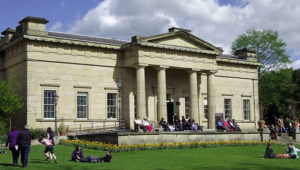Set in the centre of York, along the River Ouse, the gardens have a wonderful collection of trees, shrubs, perennial plants and bulbs. They are popular with both locals and visitors. There are large expanses of grass for the children to play and plenty of seats for adults to sit and enjoy the sunshine. Add in the historical interest with the remains of the Roman wall and the ruins of St Mary’s Abbey, there is plenty to do and see here. On a sunny Sunday in April, the ice cream van was doing a roaring trade too.
The gardens were created in 1830 for the Yorkshire Philosophical Society by the landscape architect Sir John Murray Naysmith. Originally designed as pleasure gardens, they also contained a menagerie of animals and birds. This included a very mischievous bear who had to be sent to London Zoo by stagecoach.
Now they are very attractive gardens with grass and mature trees. In spring there are flowering bulbs in the grass. Among the grass are small flower beds, each with a specific theme. Inside the main entrance off Museum Street is a rock garden using old stone coffins. The fern garden is tucked away behind the Multangular Tower along the Medieval town wall. The stones from St Mary’s Abbey are used to line the paths and make small terraces. In front of the ruins of St Mary’s Abbey is a large rock garden with alpines and dwarf conifers planted between blocks of limestone.
The Yorkshire Philosophical Society also built the splendid neo-classical “Yorkshire Museum”:http://www.yorkshiremuseum.org.uk/ for their collection of artefacts. This has displays covering biology, geology, archaeology and astronomy. Being a shame to be inside on such a nice day, we gave this a miss this visit.
The small octagonal “observatory”:http://www.historyofyork.org.uk/themes/victorian/the-york-observatory at the centre of the gardens was built at the same time and is the oldest working observatory in Yorkshire. As well as a telescope, it also contains a clock which tells the time based on the positions of the stars. It is 4 minutes, 20 seconds behind Greenwich Mean Time and was the clock by which all clocks were set in York. The observatory has been restored and is opened twice a week by volunteers, unfortunately not a day we were visiting.
The gardens are on the site of the original Roman Fortress of Eboracum. By the C4th, this was surrounded by a stone wall with towers. Part of the stone wall can be seen in the gardens along with the Multangular Tower at the north west corner of the fortress. Built of limestone, they have decorative bands of terra cotta along the walls. The tower has ten sides, was three storeys high and designed to hold a catapult. The later stone work at the top with the narrow arrow slits is medieval
The medieval wall and the Roman wall can be seen to the north of the Multangular tower. There is the remains of one a Roman interval tower can be seen along the wall. At the far end is a small Anglian defensive tower, dating from the C7th. When York was sacked by the Vikings in the C9th, They strengthened the defences by burying the Roman and Anglian walls beneath a massive earth embankment. Beyond the Anglian tower is a display showing the different levels of the banks from Roman to Medieval times.
The ruins of the nave and crossing is all that is left of “St Mary’s Abbey”:http://wasleys.org.uk/eleanor/churches/england/ruined_abbeys/st_marys/index.html founded in 1088. This was one of the wealthiest and most powerful monasteries in Medieval England and the abbey estate occupied all of the present gardens. The Hospitum was thought to have been the guest house for lower rank visitors to the abbey. It was originally part of a group of buildings that included a brew-house and stables. The stone built ground floor dates from around 1300. The timber frame upper floor is later and has been extensively restored. The ruined gateway at the side dates back to the 15th century, and was probably the entrance to a passage that ran towards the water-gate by the river.
On the opposite side of the Museum Gardens, by the entrance off Museum Street is “St Leonard’s Hospital.”:http://wasleys.org.uk/eleanor/churches/england/ruined_abbeys/st_leonards/index.html Built in the C13th on the site of an earlier building, this was the largest hospital in Northern England, run by a community of men and women of the Augustinian Order. As well as caring for the ill and infirm of York, it also distributed food to the poor as well as prisoners in York Castle. The sick could not be treated for a physical illness until they had confessed their sins. Prayers were a regular routine of the hospital. Dissolved by Henry VIII, all that is left is now the vaulted lobby, undercroft and part of the chapel walls.
The gardens are open everyday and entry is free. On Sunday afternoons there are free tours of the gardens.
There are more pictures “here.”:http://wasleys.org.uk/eleanor/gardens/england/north/museum_york/index.html








